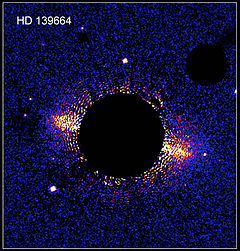 ACS image of debris disk around HD 139664 Credit: NASA/ESA | |
| Observation data Epoch J2000.0 Equinox J2000.0 (ICRS) | |
|---|---|
| Constellation | Lupus |
| Right ascension | 15 41 11.3774 |
| Declination | −44° 39′ 40.338″ |
| Apparent magnitude (V) | 4.64 |
| Characteristics | |
| Spectral type | F3/5V |
| U−B color index | −0.03 |
| B−V color index | +0.413 |
| R−I color index | +0.20 |
| Astrometry | |
| Radial velocity (Rv) | −7.08±0.03 km/s |
| Proper motion (μ) | RA: −168.70 mas/yr Dec.: −265.69 mas/yr |
| Parallax (π) | 57.09 ± 0.72 mas |
| Distance | 57.1 ± 0.7 ly (17.5 ± 0.2 pc) |
| Absolute magnitude (MV) | 3.57 |
| Details | |
| Mass | 1.368±0.026 M☉ |
| Radius | 1.26 R☉ |
| Luminosity | 3.31 L☉ |
| Surface gravity (log g) | 4.29 cgs |
| Temperature | 6,704±63 K |
| Rotational velocity (v sin i) | 71.6 km/s |
| Age | 1.11±1.40 Gyr |
| Other designations | |
| g Lupi, CD−44° 10310, CPD−44° 7529, GC 21070, GJ 594, HD 139664, HIP 76829, HR 5825, SAO 226064, PPM 320883, LTT 6256, NLTT 40843 | |
| Database references | |
| SIMBAD | data |
HD 139664 is a single star in the southern constellation of Lupus. It has the Bayer designation g Lupi; HD 139664 is the star's identifier from the Henry Draper Catalogue. It has a yellow-white hue and is visible to the naked eye with an apparent visual magnitude of 4.64. The star is located at a distance of 57 light years from the Sun based on parallax, and it is drifting closer with a radial velocity of −7 km/s. It is a member of the Hercules-Lyra Association of co-moving stars.
This is an F-type main-sequence star with a stellar classification of F3/5V, which indicates it is generating energy through core hydrogen fusion. The estimated age is poorly constrained at around one billion years, but the age of the Hercules-Lyra Association to which it belongs is 257±46 million years. It has a moderately high rate of spin, showing a projected rotational velocity of 71.6 km/s. The star has 1.37 times the mass of the Sun and 1.26 times the Sun's radius. It is radiating 3.31 times the luminosity of the Sun from its photosphere at an effective temperature of 6,704 K.
Debris disk
A debris disk has been imaged around this star using the coronagraphic mode of the ACS instrument on the Hubble Space Telescope. The disk appears to have a dust maximum at 83 AU from the star and a sharp outer boundary at 109 AU. These features may be caused by gravitational perturbations from planets orbiting the star.
References
- ^ van Leeuwen, F. (November 2007), "Validation of the new Hipparcos reduction", Astronomy and Astrophysics, 474 (2): 653–664, arXiv:0708.1752, Bibcode:2007A&A...474..653V, doi:10.1051/0004-6361:20078357, S2CID 18759600.
- ^ Desidera, S.; et al. (January 2015), "The VLT/NaCo large program to probe the occurrence of exoplanets and brown dwarfs in wide orbits. I. Sample definition and characterization", Astronomy & Astrophysics, 573: 45, arXiv:1405.1559, Bibcode:2015A&A...573A.126D, doi:10.1051/0004-6361/201323168, S2CID 55486025, A126.
- ^ Houk, Nancy (1978), Michigan catalogue of two-dimensional spectral types for the HD stars, vol. 2, Ann Arbor: Dept. of Astronomy, University of Michigan, Bibcode:1978mcts.book.....H.
- ^ Hoffleit, D.; Warren, W. H. Jr., "HR 5825, database entry", The Bright Star Catalogue (5th Revised ed.), retrieved February 4, 2011
- Reiners, Ansgar (January 2006), "Rotation- and temperature-dependence of stellar latitudinal differential rotation", Astronomy and Astrophysics, 446 (1): 267–277, arXiv:astro-ph/0509399, Bibcode:2006A&A...446..267R, doi:10.1051/0004-6361:20053911, S2CID 8642707
- ^ Luck, R. Earle (March 2018), "Abundances in the Local Region. III. Southern F, G, and K Dwarfs", The Astronomical Journal, 155 (3): 31, Bibcode:2018AJ....155..111L, doi:10.3847/1538-3881/aaa9b5, S2CID 125765376, 111.
- ^ Rhee, Joseph H.; et al. (May 2007), "Characterization of Dusty Debris Disks: The IRAS and Hipparcos Catalogs", The Astrophysical Journal, 660 (2): 1556–1571, arXiv:astro-ph/0609555, Bibcode:2007ApJ...660.1556R, doi:10.1086/509912, S2CID 11879505.
- ^ "g Lup". SIMBAD. Centre de données astronomiques de Strasbourg. Retrieved 2020-07-01.
- Halbwachs, J. -L; et al. (2018), "Multiplicity among solar-type stars. IV. The CORAVEL radial velocities and the spectroscopic orbits of nearby K dwarfs", Astronomy and Astrophysics, 619: A81, arXiv:1808.04605, Bibcode:2018A&A...619A..81H, doi:10.1051/0004-6361/201833377, S2CID 119437322.
- Lopez-Santiago, J.; et al. (2006), "The Nearest Young Moving Groups", The Astrophysical Journal, 643 (2): 1160–1165, arXiv:astro-ph/0601573, Bibcode:2006ApJ...643.1160L, doi:10.1086/503183, S2CID 119520529.
- Eisenbeiss, T.; et al. (August 2013), "The Hercules-Lyra association revisited. New age estimation and multiplicity study", Astronomy & Astrophysics, 556: 19, arXiv:1312.4045, Bibcode:2013A&A...556A..53E, doi:10.1051/0004-6361/201118362, S2CID 119275785, A53.
- Kalas, Paul; et al. (January 2006), "First Scattered Light Images of Debris Disks around HD 53143 and HD 139664", The Astrophysical Journal, 637 (1): L57 – L60, arXiv:astro-ph/0601488, Bibcode:2006ApJ...637L..57K, doi:10.1086/500305, S2CID 18293244.
| Constellation of Lupus | |||||||||||||
|---|---|---|---|---|---|---|---|---|---|---|---|---|---|
| Stars |
| ||||||||||||
| |||||||||||||
| |||||||||||||
| |||||||||||||
| |||||||||||||